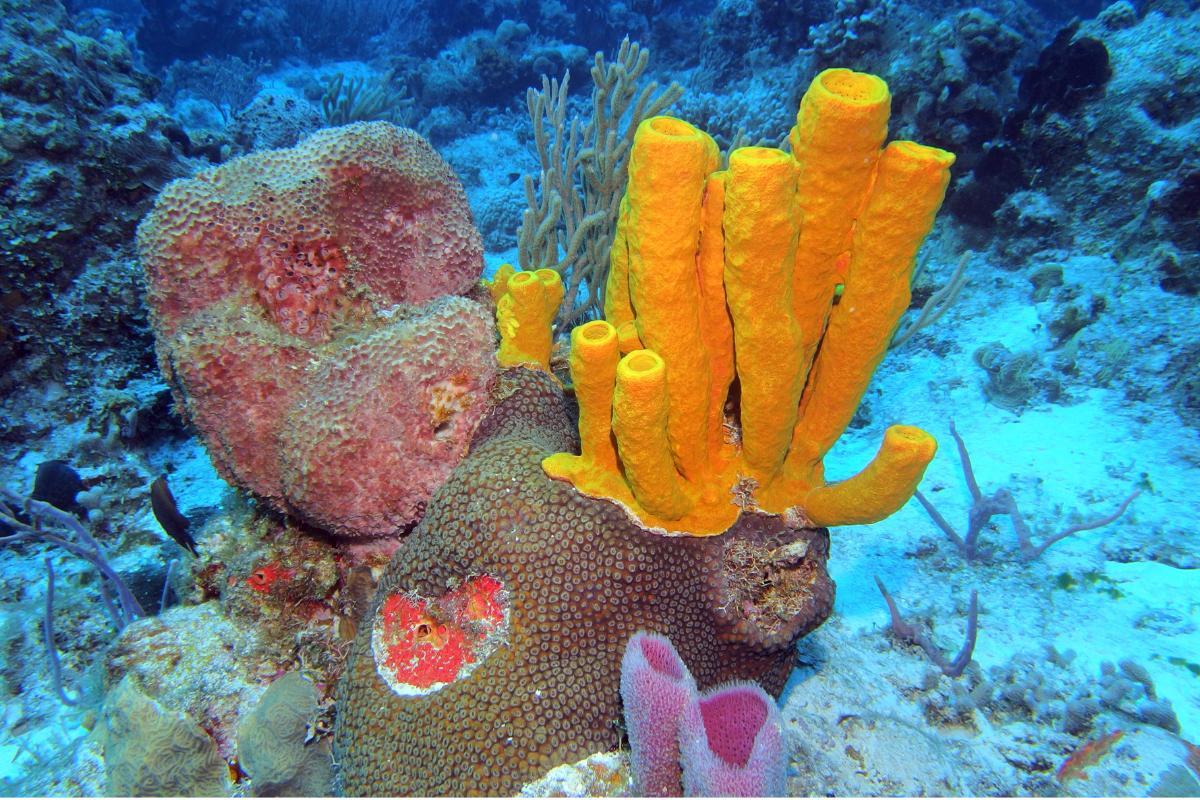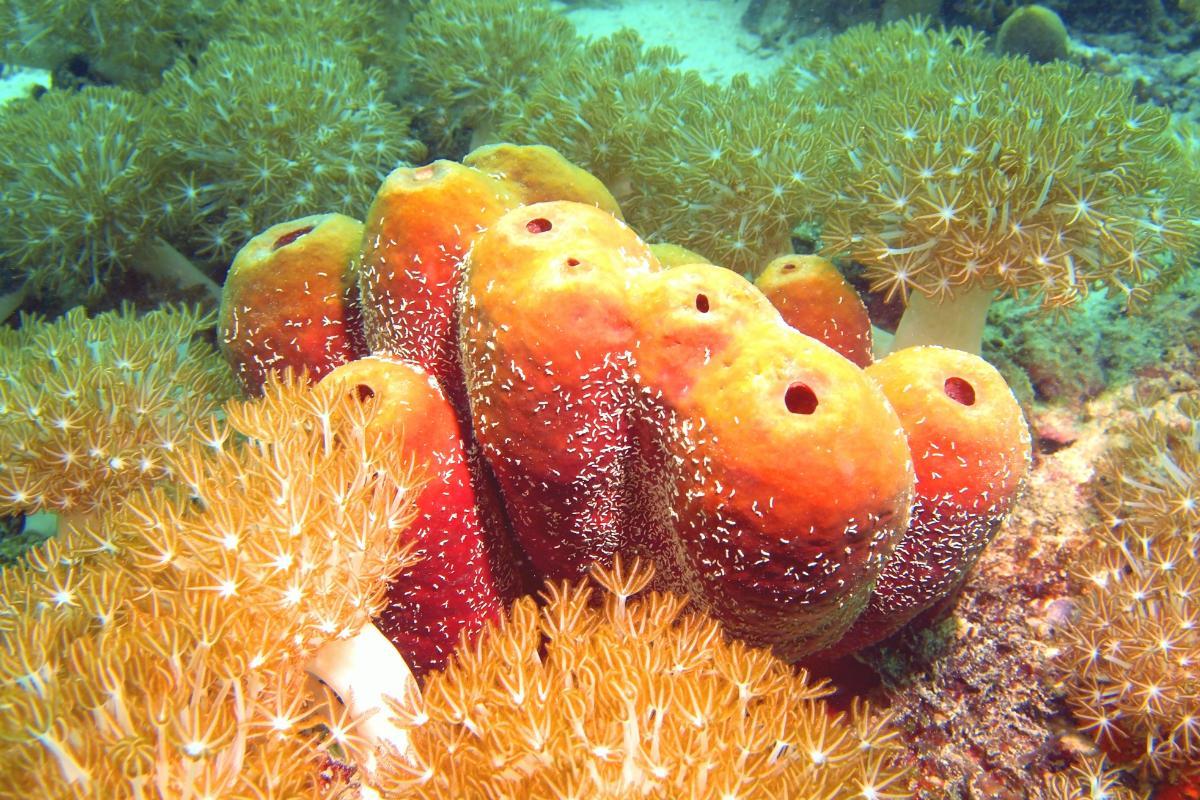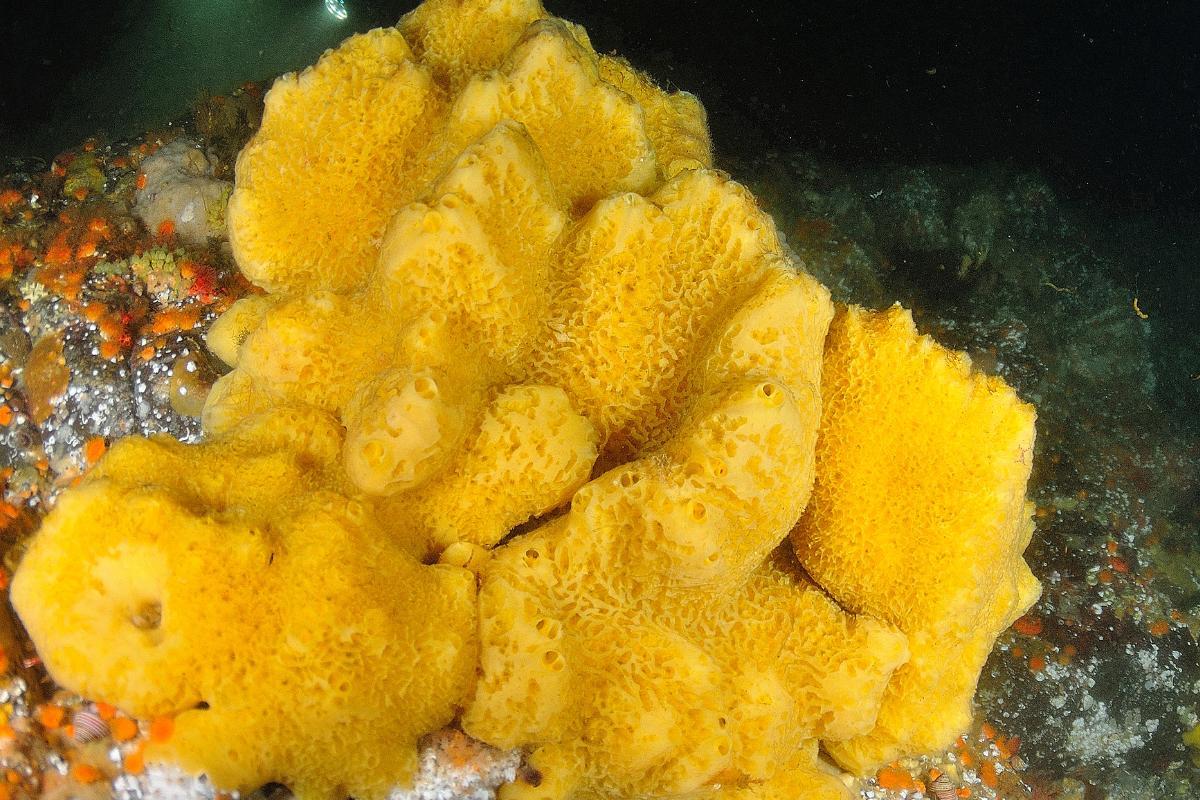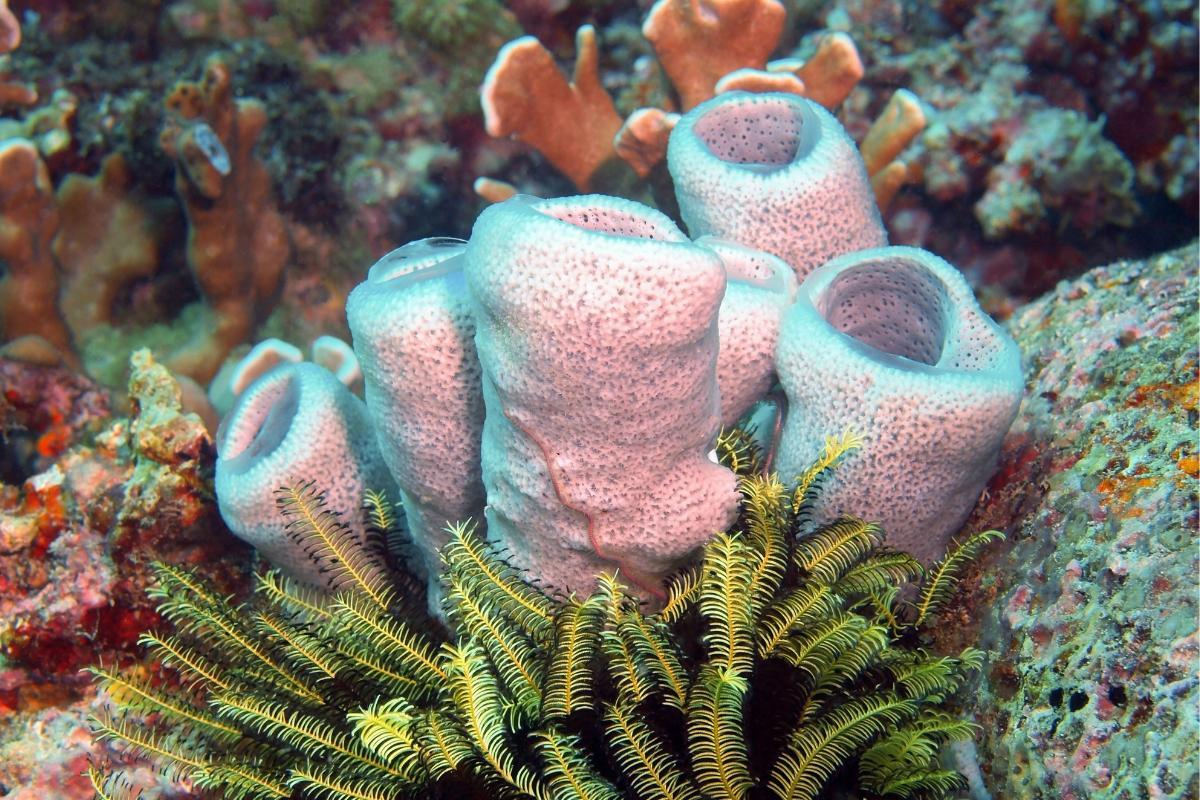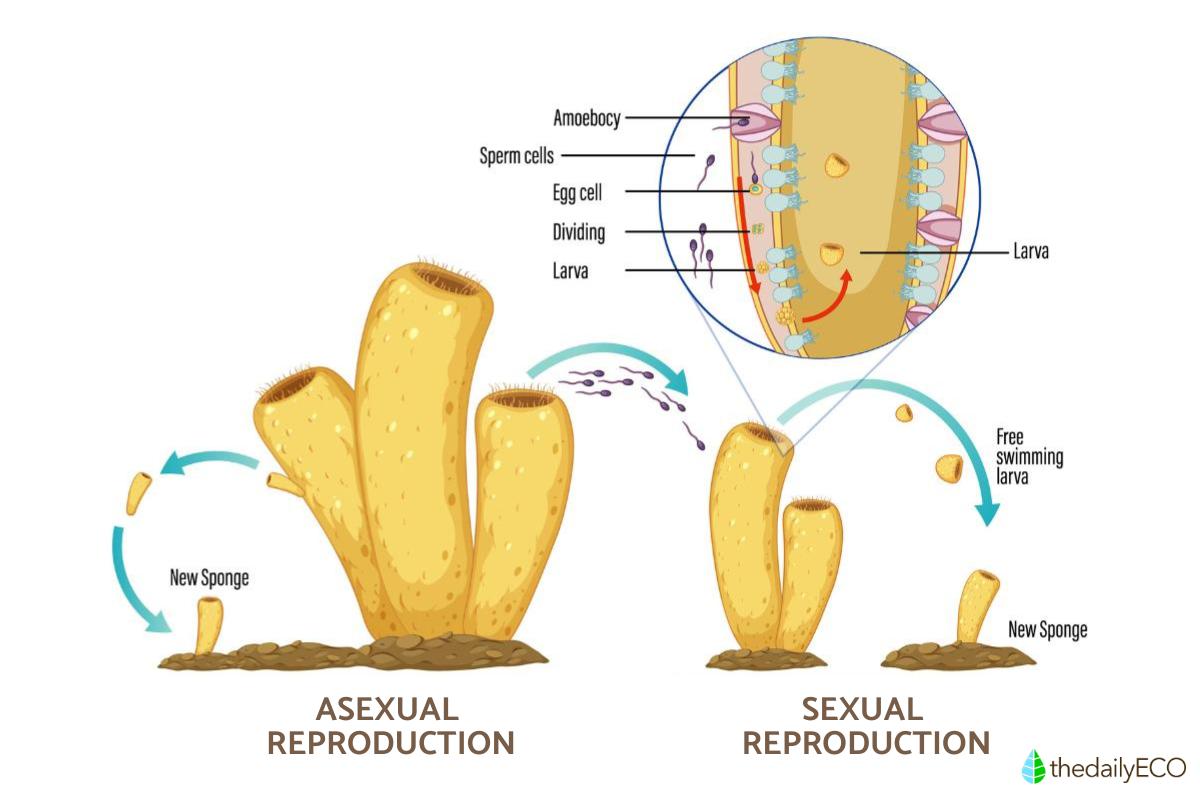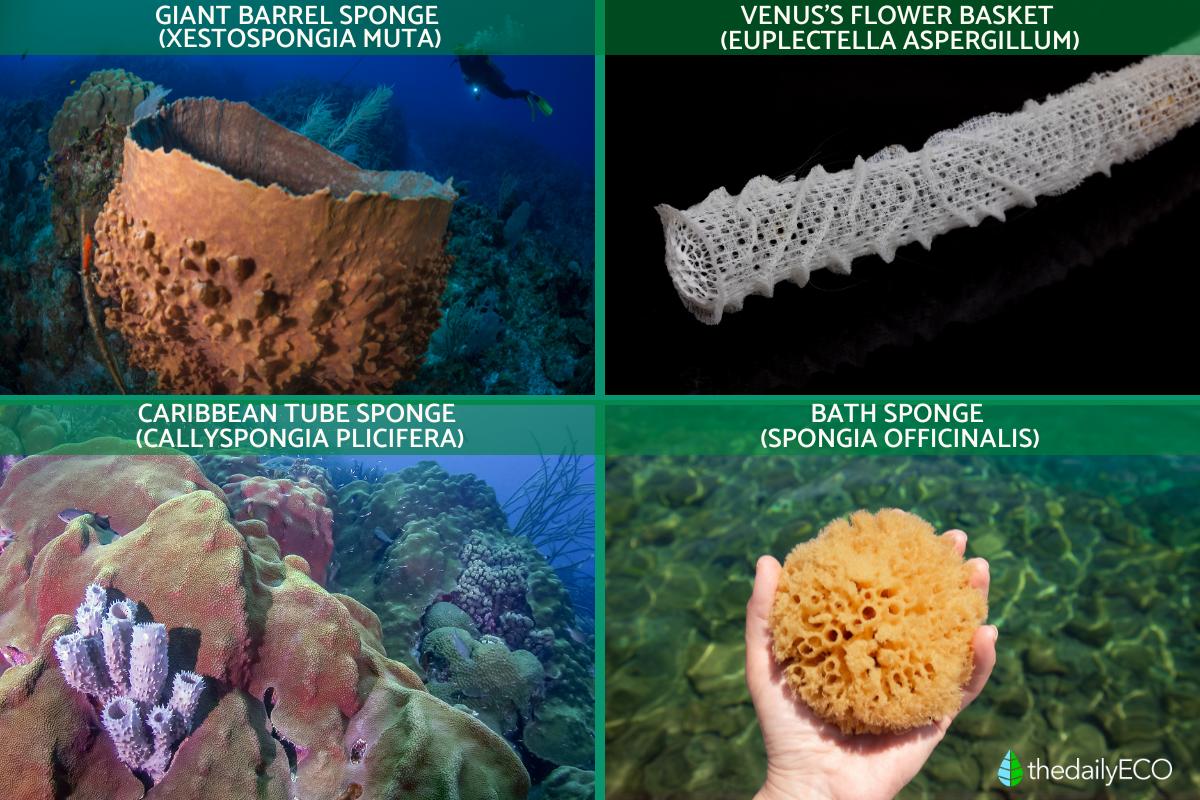What Are Sea Sponges (Porifera)?

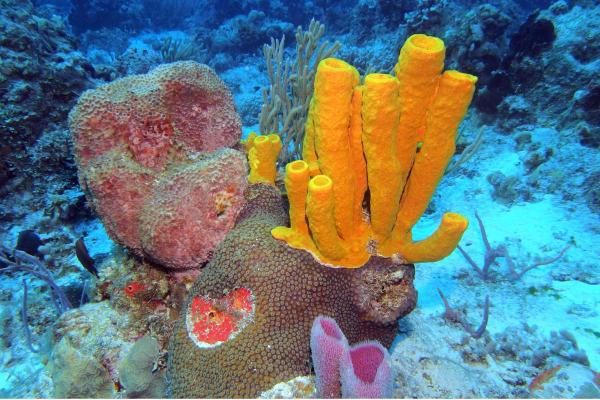
Sea sponges, scientifically known as Porifera, are among the oldest and simplest multicellular animals on Earth. These remarkable filter feeders have thrived in marine environments for over 500 million years, surviving multiple mass extinctions through their adaptable nature. From the warm waters of coral reefs to the dark depths of the ocean, sponges come in an incredible variety of shapes, sizes, and colors.
This following article by thedailyECO explores what sponges are, their main characteristics, diet, reproduction methods and importance.
What are porifera (sponges)?
Sea sponges (phylum Porifera) are one of the oldest and most successful animal groups on Earth, having existed for over 500 million years.
These multicellular organisms have evolved an efficient body design despite lacking conventional organs or symmetry. Their distinctive porous structure consists of a complex network of channels and chambers through which they pump water, enabling them to filter nutrients, breathe, and eliminate waste.
While most sponges remain permanently attached to the seafloor or other surfaces, some species can slowly crawl to new locations in response to environmental changes.
Sponges have adapted to every marine environment, from tropical coral reefs to the frigid waters of polar seas, and from shallow coastal areas to depths exceeding 8,000 meters.
Their diversity encompasses over 8,500 known species, ranging in size from tiny encrusting forms smaller than a fingernail to barrel sponges that can grow taller than a human. These animals display an extraordinary variety of shapes, including vases, tubes, fans, and spheres, while their colors span the entire spectrum from subtle browns to vibrant purples and yellows.
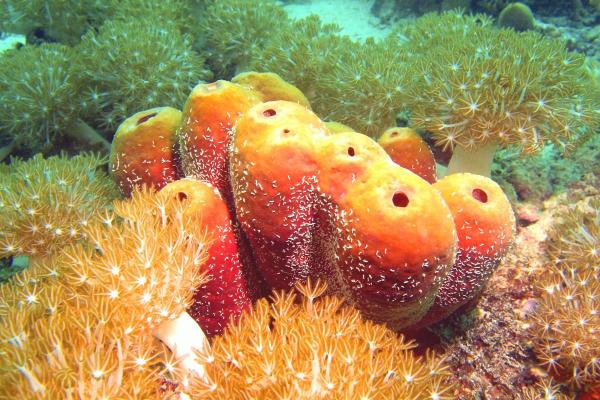
Characteristics of sponges
Sponges have a simple but effective body design built for filtering water to get food. Let's look at how their basic parts work together.
- The body is shaped like a tube with a hollow center where water flows through.Small holes in the body wall let water in, while a larger hole at the top (called the osculum) lets it out.
- The body wall has three main parts: an outer layer, a jelly-like middle layer, and an inner layer.
- Sponges come in many shapes, from simple tubes to complex branching forms.
- Different specialized cells work together in a sponge: outer cells protect and control water flow, collar cells move water and trap food, transport cells move nutrients and aid reproduction, while builder cells create the skeleton.
- Most sponges have tiny needle-like structures made of glass-like material or limestone.
- These needles can be very small or surprisingly large, up to 3 meters (10 feet) long.
- Some sponges also have flexible protein fibers for support.
- The skeleton gives the sponge its shape and helps protect it from predators.
Curious how sponges and other marine animals feed without hunting? Discover the world of filter feeders in our other article.

Types of sponges
Sponges are divided into three main classes, each with distinct skeletal compositions and structures that reflect their evolutionary adaptations to different marine environments. Let us take a closer look at each one:
Class Calcarea
Represents the smallest sponges, rarely growing beyond 15 centimetres (6 inches). These sponges build their skeletons from calcium carbonate spicules and are most commonly found in shallow, warm waters.
Their body structure can take three forms: the simple asconoid, intermediate syconoid, or complex leuconoid arrangement. Due to their calcium carbonate composition, they typically appear white or cream-colored.
Class Hexactinellida
Commonly known as glass sponges, inhabit deeper waters, usually below 500 metres (1,640 feet). Their distinctive skeleton consists of six-rayed silica spicules, giving them a crystalline appearance.
These sponges often grow into vase or funnel shapes and can reach heights of up to 1 metre (3.3 feet). They're particularly abundant in Antarctic waters and the deep Pacific Ocean.
Class Demospongiae
This is by far the most diverse and numerous group, making up about 90% of all known sponge species. These sponges can be found everywhere from deep oceans to freshwater lakes. In fact, they're the only sponges to successfully colonize freshwater environments.
Their size varies dramatically, from tiny specimens just millimetres across to impressive structures over 2 metres (6.6 feet) tall. Their skeleton combines silica spicules with spongin fibers, giving them structural variety. This class includes many familiar species, including the soft bath sponges and the massive barrel sponges.

How do sponges eat?
Sponges survive by filtering tiny food particles from water as it flows through their bodies. Water enters through small pores in their walls and exits through a larger opening at the top, creating a constant flow that brings in food and oxygen while removing waste.
Specialized collar cells (choanocytes) line the inner chambers and use their whip-like tails to create water currents. As water moves past these cells, they trap and consume bacteria and other small particles. Surface cells can also catch larger food particles, while mobile cells transport the digested food throughout the sponge's body.
This simple but effective system allows sponges to filter thousands of liters of water daily, extracting the nutrients they need to survive. Since they lack a true digestive system, this water-filtering method serves as their primary means of obtaining food and removing waste products.
How do sponges reproduce?
Sponges can reproduce in two different ways, sexually and asexually.
Asexual reproduction is quite straightforward, a piece of the sponge breaks off, drifts away, attaches to a new surface, and grows into a new sponge that's genetically identical to its parent.
Some sponges also reproduce by budding, where a new sponge grows from the parent while still attached.
Sexual reproduction in sponges is more complex. These animals are hermaphroditic, meaning each individual can produce both eggs and sperm. The sperm are released into the water through the sponge's main opening and carried by currents to other sponges, where they fertilize eggs embedded in the body tissue.
The developing embryos grow into larvae within the parent sponge. Once mature, these larvae swim freely in the water before settling down to start new sponge colonies.
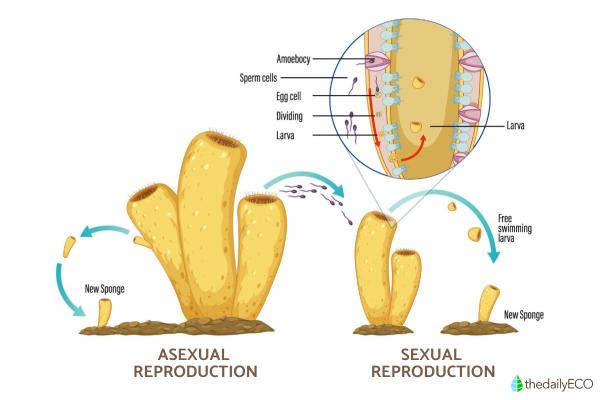
Examples of sponges
While there are thousands of sponge species, some stand out for their size, shape, or importance. Here are some interesting examples:
Giant barrel sponge (Xestospongia muta)
Found on Caribbean coral reefs, this massive sponge earns its nickname "Redwood of the Reef" by growing up to 1.8 metres (6 feet) tall and living for hundreds of years.
Its barrel-shaped body can process up to 50,000 litres of water daily, making it vital for ocean water filtration. The surface appears rough and reddish-brown, often hosting other marine organisms.
Venus's flower basket (Euplectella aspergillum)
This glass sponge creates an intricate skeleton of silica that forms a delicate, latticed tube reaching heights of 25-30 centimetres (10-12 inches). Found in deep Pacific waters, its complex structure is so remarkable that it has inspired materials scientists and engineers. In some parts of Asia, the cleaned skeleton has traditionally been given as a wedding gift.
Caribbean tube sponge (Callyspongia plicifera)
These vibrant purple or blue tube sponges often grow in clusters, with each tube reaching about 30 centimetres (12 inches) in height. Common in shallow tropical waters, they provide shelter for small fish and invertebrates. Their color comes from symbiotic bacteria that may help protect the sponge from UV damage.
Bath Sponge (Spongia officinalis)
This Mediterranean species has been harvested for thousands of years for its soft, elastic skeleton made purely of spongin fibers. Growing to about 15 centimetres (6 inches) across, these brown or black sponges have a dense network of channels that makes them excellent for holding and releasing water. While still harvested from the wild, most commercial bath sponges today come from sponge farms to protect wild populations.
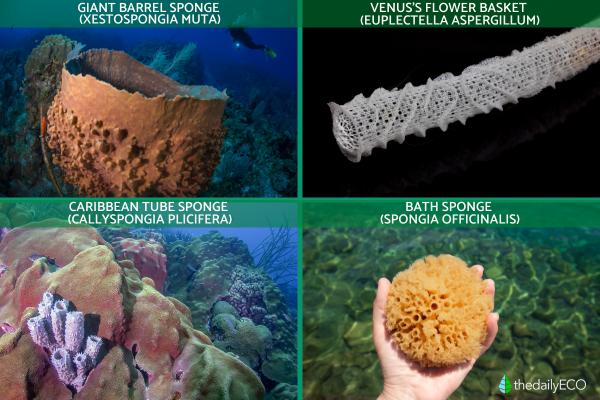
Why are sponges important?
Sponges serve as key components of marine ecosystems while also providing many benefits to humans. These animals perform ecological functions and offer resources for industries by filtering thousands of litres of water daily, removing bacteria, particles, and pollutants. In coral reefs and deep seas, they cycle nutrients by converting dissolved organic matter into forms other organisms can use. Their filtering maintains water clarity, which helps coral reef health.
Beyond their environmental role, sponges produce compounds that can fight cancer and infections, with several current medications derived from these substances. Some species provide bath and cleaning sponges, supporting coastal economies.
Their value extends to marine biodiversity, as sponges create homes for marine organisms, from shrimp to fish. Their structures provide spaces where species feed and shelter, and in deep waters, sponge gardens support communities of marine life.
As one of Earth's oldest animal groups, sponges help us understand animal evolution. Their biology influences developments in water filtration and materials science, while scientists study their compounds to develop new medications and technologies. The combination of their ecological, commercial, and scientific importance makes sponges vital organisms in both natural systems and human applications.
Sea sponges aren't the only ancient marine animals with unique filtering abilities. Learn about their distant cousins that inspired the term 'sea squirts'.
If you want to read similar articles to What Are Sea Sponges (Porifera)?, we recommend you visit our Biodiversity category.
- Jo, T. (sf). Phylum Porifera. LibreTextsBiology. https://bio.libretexts.org/Workbench/General_Biology_I_and_II/05%3A_Unit_V-_Biological_Diversity/5.07%3A_Invertebrates/5.7.02%3A_Phylum_Porifera
- Maldonado, M. and Riesgo, A. (2008). REPRODUCTION IN THE PHYLUM PORIFERA: A SYNOPTIC OVERVIEW. Biology of reproduction (Mercè Durfort i Francesca Vidal, ed.). DOI: 102436/2015010256 Bio
- Rajesh, K. (2020). CHARACTERS AND CLASSIFICATION OF PHYLUM PORIFERA. Bhagalpur National College. https://bncollegebgp.ac.in/wp-content/uploads/2020/04/BSc-Zoology-Part-I-Porifera.pdf





